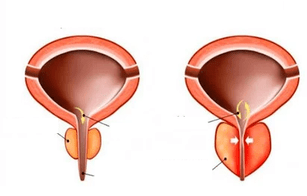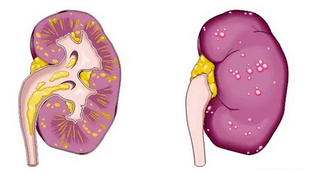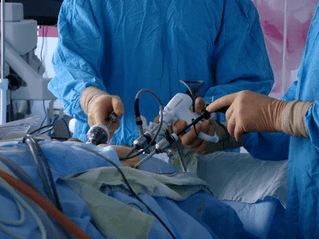
Many doctors jokingly call menopause menopause. Such a disease is diagnosed in 20% of cases in men after forty years, in 70% - after sixty years, and in 90% of cases after the age of seventy. The disease can take two forms: acute and chronic prostatitis. This disease needs to be treated, especially because it is used well in therapy. But many men ignore unpleasant symptoms, leading to a number of complications that are harder to treat.
Development Reasons
Acute prostatitis is an acute pathology of the prostate that develops as a result of an inflammatory and infectious process in an organ due to the penetration of pathogens into the tissues. The disease is characterized by the appearance of swollen glands and purulent contents in their tissues.This leads to a number of unpleasant symptoms, impaired functioning of the organs of the urogenital system.
There are several causes of acute prostatitis. In most cases, it is provoked by pathogenic microbes.Some microbes can passively pass through the skin or intestines in a healthy person. They are activated by certain factors, penetrate the tissues of the gland and actively multiply there. Often the disease is caused by STDs such aschlamydia, ureaplasmosis, gonorrhea, etc.
In addition, the acute form of prostatitis occurs as a complication ofurethritis. Germs enter the urethra through channels that open. In addition, the spread of bacteria from other organs of the urogenital system often becomes the cause of the appearance of prostatitis. Often the gland can be affectedduring surgical procedures, catheterization, diagnostic procedures.
Because there are a large number of blood vessels in the prostate gland, chronic infections of the blood can come here in the presence of chronic diseases of the body, such astonsillitis, bronchitis, and so on.In the presence of anal fissures, microbes can enter the prostate through lymph flow.
But infections do not always lead to disease. Congestion in the pelvic vessels, which results fromprolonged or prolonged sexual intercourse.
congestion is also associated withlack of physical activity, constant constipation, alcoholism, pelvic varicose veins, hypothermia.
Classification
Urology distinguishes between several forms of pathology, which are also developmental stages:
- The
- catarrhal formis characterized by the appearance of inflammation in the organ, a change in the mucous membrane. Over time, the gland swells and mucus secretions accumulate in it, contributing to the progression of the disease.
- The focal supuration then appears. The disease enters the second stage (form) -follicular form. The urinary tract narrows or clogs, the secret ceases to be normally excreted from the organ. Pus can be secreted into the urinary tract, forming purulent foci. The cells of the gland change, the prostate continues to swell and grow.
- Parenchymal formdevelops when an organ is completely inflamed, a purulent infection develops in it. In the absence of therapy, the small purulent foci merge into a huge, abscess that often opens into the urethra, intestines, and bladder. In some cases, it is possible for this form of pathology to develop immediately when the infection enters the interstitial tissue of an organ through the flow of blood or lymph.

Symptoms
Shows symptoms of acute prostatitis. How visible and perceptible the signs are depends on the form (stage) of the disease. Common symptoms of the disease include:
- pain syndrome during urination; symptoms of
- poisoning;
- pain in the genital area;
- frequent urge to use the toilet, especially at night;
- possible discharge from the urethra.
As a man's prostatitis progresses, the pain syndrome spreads to other areas. This is due to the transmission of impulses along the nerve endings. Excretion of urine will be very painful. At this stage, an acute delay often develops, which is considered a dangerous condition as it can lead to rupture of the bladder.
Symptoms of acute prostatitis continue to increase. During bowel movements, severe pain occurs and body temperature rises. The prostate will enlarge, become tense and painful. Urine will be cloudy due to the content of pus and mucus.
In the last stage, the disease manifests itself strongly.
Body temperature rises greatly, accompanied by fever and chills, loss of appetite, severe weakness, exhaustion of the whole body. Urination can stop completely and the man will experience acute severe pain when he tries to go to the toilet. This condition is excruciating, the pain syndrome begins to spread throughout the pelvic region. One cannot find a place for oneself, forced to lie with retracted limbs. If the inflammation has spread to the rectum, mucus comes out of the anus. Yellowish-green mucus mixed with blood is released from the urinary tract.

This condition can causesepsis, cystitis, pyelonephritis, chronic prostatitis, abscess. In this case, urgent hospital care and emergency care is required.
Diagnostics
Because the symptoms of acute prostatitis in men are quite pronounced, the doctor may immediately suspect pathology. But you need a thorough investigation. Rectal examination in this case is strictly contraindicated.
The urologist must use laboratory and instrumental techniques to determine the stage (form) of the disease. The doctor will take aprostate secretfor examination. The concentration of leukocytes in it increases, indicating acute inflammation.
Thenlaboratory tests are performed on blood and urine. Urine is sent for bacteriological culture for testing and to determine its susceptibility to the pathogen of the infection and antibacterial drugs. It is also possible to do the following:
- PCR to detect STD;
- uroflometry to identify the severity of organ disorders;
- Prostate ultrasound to determine organ shape and size, changes, stage of disease;
- dopplerometry helps to distinguish acute prostatitis from other pathologies; MR planning of pelvic organs is often prescribed when planning surgery;
- analysis of blood SPA concentration;
- examination of urethral secretion smear;
- Puncture of organ parts with suspected purulent infection and abscess.
Management
Your urologist will explain in detail how to treat acute prostatitis. The main component of the therapy is an antibacterial drug that is selected in accordance with the results of bacterial culture. Within two to three days, the antibiotic begins to help, the person feels much better, the pain begins to subside. But with this form of the disease, such medications must be taken for a month, even if the symptoms have completely disappeared.
The disease should also be prevented from becoming chronic, which is quite common.
Your doctor will also consider other factors when choosing a medication:
- some agents do not penetrate well into glandular tissues;
- Other agents accumulate in large amounts in tissues.
Acute prostatitis in men should be based on the use of strong drugs as in other cases that endanger human life. Generally, doctors prescribe fluoroquinolones. When using macrolides, the dosage should be high. This is especially true in immunosuppressed patients.
Antibiotics are usually given as intravenous injections. In the initial stage, the disease can be treated at home or on an outpatient basis.In this case, bed rest is prescribed, as any application of force can cause the spread of infection and the development of sepsis.
In combination with antibiotics, the following medications are also prescribed:
- analgesics;
- antipyretics;
- NSAIDs;
- opiates can be prescribed for severe pain;
- diuretics to reduce body poisoning;
- laxatives to facilitate bowel movements;
- antispasmodics to facilitate urinary excretion;
- alpha-blockers.
If a man has acute urinary retention, urea catheterization is performed. Antiandrogens are often used to reduce swelling and inflammation in the organ, to improve the outflow of secretions, to normalize blood flow to the gland, and to reduce the risk of the infection spreading in the body.
Use of hormones such as estrogen, cold enemas to relieve swelling and pain. Massages and thermal treatments for this form of the disease are strictly prohibited. They can only be used during the recovery period.
Surgery

In the absence of pain, the doctor may suspect the formation of an abscess. In this case, a surgical procedure is performed to eliminate the area where it occurs. Defective abscess drainage is often used. In severe and extreme cases, the organ is removed.
Surgery is prescribed for abscesses, acute urinary retention, severe pain syndrome that cannot be eliminated by any medication, the appearance of stones and neoplasms, and the ineffectiveness of medication, common infections of the urogenital system, paraproctitis.
A surgeon may use one of the following techniques:
- TRUP (transurethral resection)means the removal of the inside of the organ. Most commonly used;
- Prostatectomymeans the partial or complete removal of an organ through an incision in the lower abdomen;
- Laser surgery. In this case, the affected areas of the organ are removed with a laser;
- The abscess is emptied through the rectum. A drain is inserted into the incision through which pus is pumped out;
- Atransurethral incisionis made in the organ to facilitate the excretion of urine.
When the structure of the tissues of the gland is restored, its functions are normalized, the secret of the prostate normalizes its composition, the pathogen of the pathology is completely eliminated from the body, we can talk about the cure of prostatitis.
Forecast
With therapy, the prognosis of the disease will be good. Sometimes the negative consequences of acute prostatitis develop. The disease can become chronic, it will be more difficult to eliminate. The dangerous consequences of untreated disease are organ abscess, sepsis, and acute urinary retention. In some cases, death can occur due to the appearance of complications. But in general, men do not allow such consequences to develop as they seek medical attention and begin therapy.
Prevention

For prevention, predisposing factors should be prevented. This requires timely treatment of all infections in the body so that they do not become chronic and become a potential foci of infection that spreads to the prostate gland.
Physicians should monitor the use of antiseptics during surgery. Otherwise, the risk of pathogens entering the patient's body increases. It is important for a man and his sexual partner to treat sexually transmitted diseases in a timely manner and it is best to prevent their occurrence. Sex life has to happen with a regular partner, it has to be regular.
You must lead an active lifestyle, play sports or exercise, and follow the rules of intimate hygiene.
Men usually see a doctor in an emergency. But when negative signs appear, it is better to contact them immediately. This can help avoid many health problems and in some cases can even save lives.
























